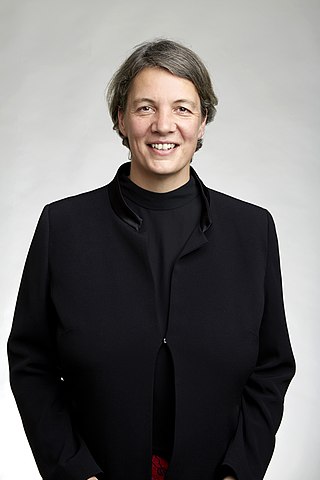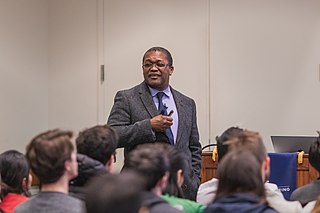Related Research Articles

John Bannister Goodenough was an American materials scientist, a solid-state physicist, and a Nobel laureate in chemistry. From 1996 he was a professor of Mechanical, Materials Science, and Electrical Engineering at the University of Texas at Austin. He is credited with identifying the Goodenough–Kanamori rules of the sign of the magnetic superexchange in materials, with developing materials for computer random-access memory and with inventing cathode materials for lithium-ion batteries.
Adrienne Elizabeth Clarke is professor emeritus of Botany at the University of Melbourne, where she ran the Plant Cell Biology Research Centre from 1982 to 1999. She is a former chairman of the Commonwealth Scientific and Industrial Research Organisation, former Lieutenant Governor of Victoria (1997–2000) and former Chancellor of La Trobe University (2011–2017).
Sossina M. Haile is an American chemist, known for developing the first solid acid fuel cells. She is a professor of materials science and engineering at Northwestern University, Illinois, US.
Gordon Wallace, AO, FAA, FTSE, FRACI is a leading scientist in the field of electromaterials. His students and collaborators have pioneered the use of nanotechnology in conjunction with organic conductors to create new materials for energy conversion and storage as well as medical bionics. He has developed new approaches to fabrication that allow material properties discovered in the nano world to be translated into micro structures and macro scopic devices.

Michelle Yvonne Simmons is an Australian quantum physicist, recognised for her foundational contributions to the field of atomic electronics.

Tanya Mary Monro is an Australian physicist known for her work in photonics. She has been Australia's Chief Defence Scientist since 8 March 2019. Prior to that she was the Deputy Vice Chancellor, Research and Innovation (DVCR&I) at the University of South Australia. She was awarded the ARC Georgina Sweet Australian Laureate Fellowship in 2013. She was the inaugural chair of photonics, the inaugural director of the ARC Centre of Excellence for Nanoscale Biophotonics and the inaugural director of the Institute for Photonics & Advanced Sensing (IPAS), and the inaugural director of the Centre of Expertise in Photonics (CoEP) within the School of Chemistry and Physics at the University of Adelaide. Monro has remained an adjunct professor of physics at the University of Adelaide following her departure from the institution. In 2020 she was awarded the title of Emeritus Professor at the University of South Australia.
Michelle Louise Coote FRSC FAA is an Australian polymer chemist. She has published extensively in the fields of polymer chemistry, radical chemistry and computational quantum chemistry. She is an Australian Research Council (ARC) Future Fellow, Fellow of the Royal Society of Chemistry (FRSC) and Fellow of the Australian Academy of Science (FAA).
Martina Heide Stenzel is a Professor in the Department of Chemistry at the University of New South Wales (UNSW). She is also a Royal Australian Chemical Institute (RACI) University Ambassador. She became editor for the Australian Journal of Chemistry in 2008 and has served as Scientific Editor and as of 2021, as Editorial Board Chair of RSC Materials Horizons.

Rose Amal is an Australian chemical engineer, currently serving as Scientia Professor and ARC Laureate Fellow in the School of Chemical Engineering at the University of New South Wales, Australia, where she is the director of the Particles and Catalysis Research Group. Previously she was Director of the ARC Centre of Excellence for Functional Nanomaterials (2010–2013). From 2012 to 2015 she was named in the Engineers Australia list of Australia's Top 100 Most Influential Engineers. In 2014 she became the first female engineer elected a Fellow of the Australian Academy of Science.
Svetha Venkatesh is one of the top 15 women in the world in Artificial Intelligence. She is Indian/Australian and is an Alfred Deakin Professor in the Faculty of Science, Engineering & Built Environments, in the Department of Pattern Recognition and Data Analytics at Deakin University, as well as a professor of computer science and director of the Centre for Pattern Recognition and Data Analytics (PRaDA) at Deakin. She was elected a Fellow of the International Association of Pattern Recognition in 2004 for her contributions to the "formulation and extraction of semantics in multimedia data". She was also elected a Fellow of the Australian Academy of Technological Sciences and Engineering in 2006 and an ARC Laureate Fellow in June 2017. She was elected a Fellow of the Australian Academy of Science in May 2021.
Marcela Bilek is a Professor of Applied Physics and Surface Engineering at the University of Sydney, Australia. Her research interests focus on the use of plasma related methods to synthesise thin film materials and modify surfaces and interfaces. She was named Fellow of the American Physical Society in 2012 and Fellow of the Institute of Electrical and Electronics Engineers (IEEE) in 2015 for contributions to the science and application of plasma processes for materials modification and synthesis.

Maria Helena Sousa Soares de Oliveira Braga is an associate professor at the Engineering Physics Department of University of Porto, Portugal. She is currently focused on research areas in Materials Science and Materials Engineering at University of Porto and University of Texas at Austin. She is credited with expanding the understanding of glass electrolyte and glass batteries with colleague John B. Goodenough. Braga is a senior research fellow in the Materials Institute headed by Goodenough.

Professor Branka Vucetic is an Australian-based expert in coding theory and its applications in wireless technology. She works at the University of Sydney where she holds the positions of ARC Laureate Fellow, Peter Nicol Russell Chair in Telecommunications, and Director of the Centre of Excellence in Telecommunications.
Kate Amanda Smith-Miles is an Australian applied mathematician, known for her research on neural networks and combinatorial optimization. She is a Melbourne Laureate Professor of applied mathematics at the University of Melbourne, and a former president of the Australian Mathematical Society.
Ivan Marusic is an Australian engineer and physicist. He is known for his work on turbulence at high Reynolds number, using both theoretical and experimental approaches.
Maria Skyllas-Kazacos AM FTSE is an Australian chemical engineer best known for her pioneering work of the vanadium redox battery, which she created at the University of New South Wales in the 1980s. Her design used sulfuric acid electrolytes and was patented by the university. In 1999 she was appointed a Member of the Order of Australia "for service to science and technology, particularly in the development of the vanadium redox battery as an alternative power source".
Linda Faye Nazar is a Senior Canada Research Chair in Solid State Materials and Distinguished Research Professor of Chemistry at the University of Waterloo. She develops materials for electrochemical energy storage and conversion. Nazar demonstrated that interwoven composites could be used to improve the energy density of lithium–sulphur batteries. She was awarded the 2019 Chemical Institute of Canada Medal.
Anita J. Hill is an Australian researcher in materials and process engineering. She is a former Chief Scientist of the Commonwealth Scientific and Industrial Research Organisation (CSIRO), and the current Executive Director of Future Industries at CSIRO. Her research focuses on the transport of atoms, ions and small molecules in condensed matter, notably using positron annihilation spectroscopy.

Lynden A. Archer is a chemical engineer, Joseph Silbert Dean of Engineering, David Croll Director of the Energy Systems Institute, and professor of chemical engineering at Cornell University. He became a fellow of the American Physical Society in 2007 and was elected into the National Academy of Engineering in 2018. Archer's research covers polymer and hybrid materials and finds applications in energy storage technologies. His h-index is 92 by Google Scholar.
Zaiping Guo is an Australian engineer and academic. She specializes in nanomaterials for lithium-ion batteries used in electric vehicles and portable equipment. She headed the Institute of Superconducting and Electronic Materials at the University of Wollongong before winning an Australian Research Council grant for a five-year project in the same field at the University of Adelaide, where she is currently a professor. In 2023 she was elected a Fellow of the Australian Academy of Science (FAA) and of the Australian Academy of Technological Sciences and Engineering (FTSE).
References
- 1 2 "Maria Forsyth". Ikerbasque Basque Foundation for Science. 31 August 2018. Retrieved 2 October 2018.
- 1 2 3 4 "Professor Maria Forsyth - Our People - ARC Centre of Excellence for Electromaterials Science". www.electromaterials.edu.au. Retrieved 2 October 2018.
- 1 2 "Professor Maria Forsyth". Australian Academy of Science. Retrieved 2 October 2018.
- ↑ "ペニスの大きさとアルコールや喫煙の関係について". ペニス増大サプリ最強ランキング! (in Japanese). Retrieved 25 April 2020.
- ↑ Biscevic, Tajna (6 March 2020). "Deakin scientists develop better performing lithium batteries". Manufacturers' Monthly. Retrieved 25 April 2020.
- ↑ "Professor Maria Forsyth awarded Australian Laureate Fellowship". Deakin University . 8 August 2011. Retrieved 3 May 2020.
- ↑ "Professor Maria Forsyth". www.vic.gov.au. Retrieved 23 March 2020.
- ↑ "Maria Forsyth FTSE FAA". Australian Academy of Technological Sciences and Engineering. Retrieved 24 October 2022.
- ↑ "King's Birthday 2023 Honours - the full list". Sydney Morning Herald. Nine Entertainment Co. 11 June 2023. Retrieved 11 June 2023.